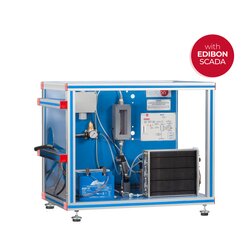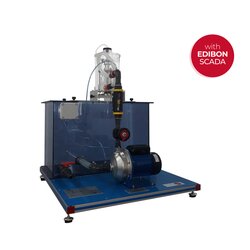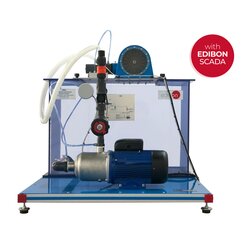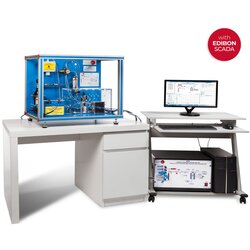Computer Controlled Single Water Pumping Application (SWPC)



PL-167815
The "SWPC" Computer Controlled Single Water Pumping Application, developed by EDIBON, is designed to demonstrate the fundamental operation principles of pumping units within isolated networks. This unit includes two water tanks placed at different heights, connected by a pump and PVC piping to replicate a real-world pumping system. A unique feature of the application is its proportional valve, which allows users to adjust the valve's opening level to create varied manometric pressures at the pump outlet, effectively controlling the pumping height of the system. With this setup, water can be pumped from the lower tank (ground water) to the upper tank (storage tank) after the desired pressure is configured.
The application incorporates an industrial pump regulator, engineered specifically to maximize available energy for pumping. When solar radiation is minimal, the regulator optimizes the current-voltage (I-V) curve to extend pumping hours, allowing students to analyze these device operations and their value in systems that regulate voltage for optimal pump operation.
A range of sensors, actuators, and indicators facilitates complete monitoring, supervision, and control. These include a tank level sensor, flow and pressure sensors, a maximum level stop in the upper tank to prevent overflow, a minimum level stop in the lower tank to avoid pump damage, along with various pump operation indicators and control switches. The SCADA software’s data acquisition system and internal meters display real-time sensor data and actuator status, including the regulator's input and output voltage and current. Furthermore, users can analyze the system’s energy flows, assessing the potential energy of the pumped water and the electricity required to transfer this energy to the storage tank.
For a more comprehensive learning experience, a photovoltaic panel, wind turbine, batteries, and respective regulators are recommended as supplementary components to showcase how an isolated network pumping system operates. The SWPC application also includes a detailed manual, which covers the theoretical and practical aspects of photovoltaic and wind-powered water pumping systems, the architecture of pumping and irrigation setups, energy flow analyses, and the dimensioning of solar pumping installations.
- SWPC. Unit:
- N-ALI02. Domestic Main Power Supply Module.
- N-PRC. Pumping Local Control Module.
- N-DCPWS-36V/150W. 36 VDC, 150 W Power Supply Module.
- MED65. Digital Multimeter.
- PTWT. Pumping Unit with Two Water Tanks.
- All necessary cables to realize the practical exercises are included.
Additional recommended elements (Not included):
- PV-KIT-300W. 300W Photovoltaic Kit with Regulator and Measurement Instrumentation.
- LP6. 6 Lamps Panel with Dimming.
- N-REG-AC/LR. AC Local/Remote Current Regulator Module.
- N-MED16. DC Voltmeter Module (0-50 V).
- N-MED81. DC Ammeter Module (0-30 A).
- PV-24/300W. Photovoltaic Panel, 24 VDC, 300 W.
- BAT2. AGM Battery, 25 Ah, 12 V (2 units).
- N-REG03. MPPT Regulator Module.
- WT-KIT-400W. 400 W Wind Turbine Kit with Regulator and Measurement Instrumentation.
- WT-24V/400W. Permanent Magnets Wind Turbine 24 V, 400 W.
- N-REG-24V/400W. Wind Turbine Regulator Module 24 V, 400 W.
- N-TPAD-3PH/400V. 400 V Three-Phase AC/DC Converter Module.
- N-MED16. DC Voltmeter Module (0-50 V).
- N-MED81. DC Ammeter Module (0-30 A).
- BAT2. AGM Battery, 25 Ah, 12 V (2 units).
- N-SERV400W. 400 W Servomotor Controller Module.
The complete unit includes as well:
- Advanced Real-Time SCADA.
- Open Control + Multicontrol + Real-Time Control.
- Specialized EDIBON Control Software based on LabVIEW.
- National Instruments Data Acquisition board.
- Calibration exercises, which are included, teach the user how to calibrate a sensor and the importance of checking the accuracy of the sensors before taking measurements.
- Projector and/or electronic whiteboard compatibility allows the unit to be explained and demonstrated to an entire class at one time.
- Capable of doing applied research, real industrial simulation, training courses, etc.
- Remote operation and control by the user and remote control for EDIBON technical support, are always included.
- Totally safe, utilizing 4 safety systems (Mechanical, Electrical, Electronic and Software).
- Designed and manufactured under several quality standards.
- Optional ICAI software to create, edit and carry out practical exercises, tests, exams, calculations, etc. Apart from monitoring user’s knowledge and progress reached.
- This unit has been designed for future expansion and integration. A common expansion is the EDIBON Scada-Net (ESN) System which enables multiple students to simultaneously operate many units in a network.
- SWPC/CCSOF. Computer Control + Data Acquisition + Data Management Software.
- Cables and Accessories, for normal operation.
- Manuals: This unit is supplied with 7 manuals. Required services, Assembly and Installation and Control software, Starting-up, Safety, Maintenance, Calibration and Practices manuals.
EXERCISES AND PRACTICAL POSSIBILITIES TO BE DONE WITH THE MAIN ITEMS
- Starting and stopping the pumping system.
- Automatic stop in maximum and minimum level conditions.
- Study of the working regime of the pumping regulator: adjustment and reduction of voltage.
- Commissioning of the solar battery pumping system (requires the PV-KIT-300W).
- Commissioning of the solar pumping system without batteries (requires the PV-KIT-300W).
- Study of the working regime of the pumping regulator: shadow effect (requires the PV-KIT-300W).
- Study of the working regime of the pumping regulator: variations of pumped flow (requires the PV-KIT-300W).
- Starting thresholds with and without converter (requires the PVKIT-300W).
- Commissioning of the battery-powered wind pumping system (requires the WT-KIT-400W).
- Commissioning of the wind power pumping system without batteries (requires the WT-KIT-400W).
- Several other exercises can be done and designed by the user.
What is this?
These percentage scores are an average of 0 user reviews. To get more into detail, see each review and comments as per below
If you have used this product, support the community by submitting your review



